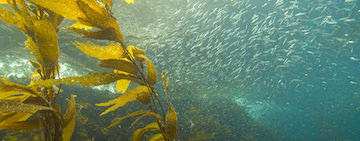381315-seaweed.jpg

Kelp forest in the Channel Islands National Marine Sanctuary and National Park. Credit: National Oceanic and Atmospheric Administration
Seaweed is hot. Or, if you prefer, you can have it cold. No matter how you like it, though, seaweed is becoming more popular in the United States and other countries around the world. It’s served in salads and main courses, and it’s ground up to use as seasoning. And an extract from seaweed forms a thickener in gelatins and a binder in toothpaste.
But the name “seaweed” is a bit misleading. That’s because, unlike land-based weeds, it doesn’t have roots or stems or leaves. Instead, seaweed is a type of algae. It absorbs nutrients and water directly from the saltwater around it.
There are thousands of varieties of seaweed: kelp, sea lettuce, sea spaghetti, nori, and many others. Some are tiny, while others can grow to more than a hundred feet in length. Some are anchored to the seabed, while others float with the currents. And they come in three main colors: green, red, and brown.
The green algae grow at depths of no more than about 15 to 20 feet. Red and brown algae have pigments that can absorb different wavelengths of light than the green algae, so they can live at greater depths — up to several hundred feet.
Seaweeds have become more popular in recent years in part because they have some good nutritional properties. They have high levels of fiber, protein, and iodine, for example. And they can be farmed with little impact on the environment. So whether you prefer it hot, cold, or sprinkled on your eggs, seaweed is a food you’re likely to see a lot more often in the years ahead.
This episode of Science and the Sea was made possible by Texas Sea Grant.

